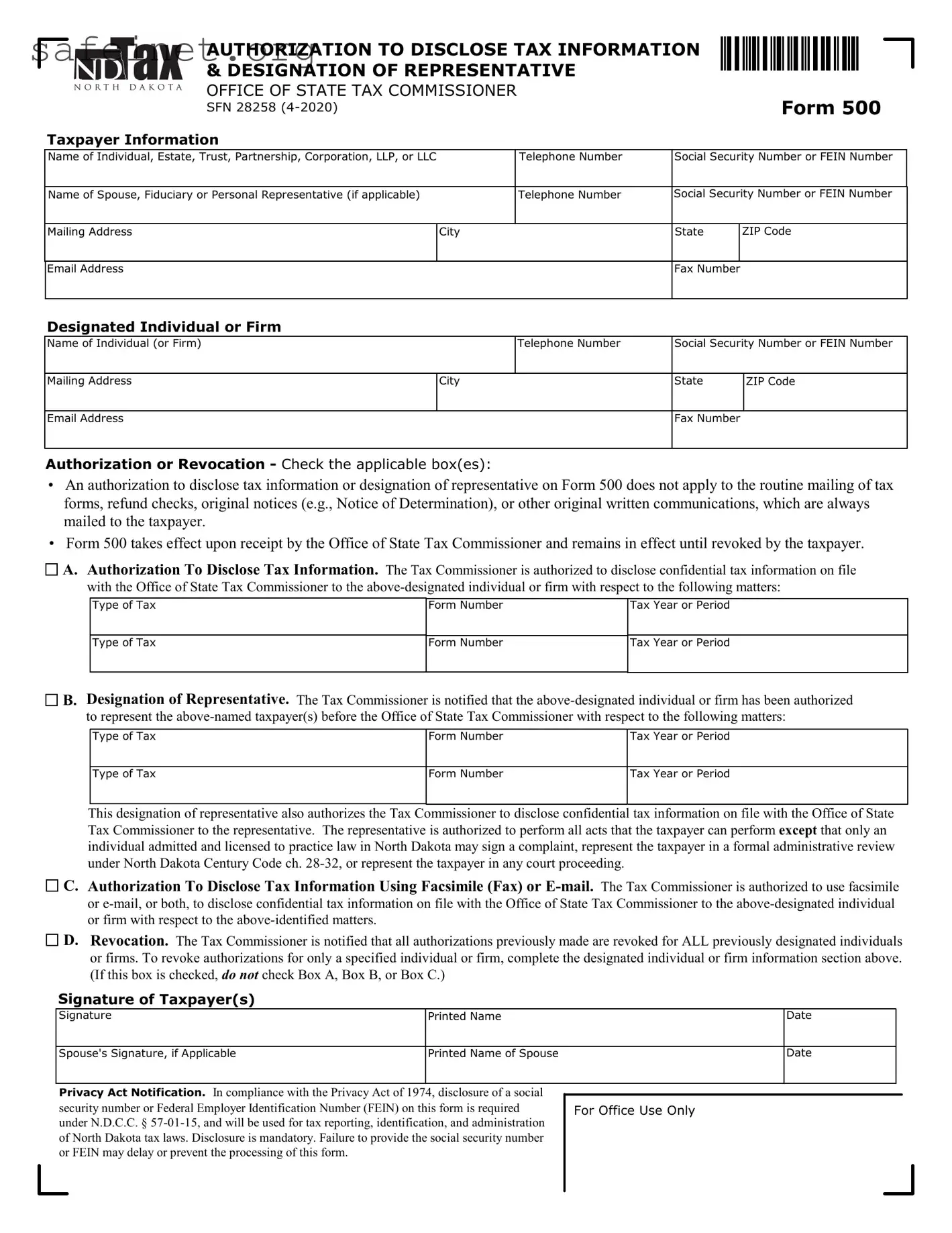The IRS Form 2848, Power of Attorney and Declaration of Representative, serves a similar purpose as Tax POA 500. Both forms enable individuals to authorize a representative to act on their behalf in tax matters. Form 2848 is specific to federal tax issues, allowing the appointed representative to handle most IRS business, whereas Tax POA 500 may be geared more toward state-specific tax concerns. Each form requires the taxpayer's consent and detailed information about the representative's authority.
The IRS Form 8821, Tax Information Authorization, is often compared to the Tax POA 500. While Tax POA 500 allows a representative to make decisions, Form 8821 only grants authorization to receive tax information. This distinction is crucial when individuals simply want their representatives to be informed without granting them decision-making power. Both forms require accurate sections to identify the taxpayer and the type of tax involved.
Power of Attorney forms used by various states, such as California’s Form FTB 3520, share similarities with Tax POA 500. These state-specific forms empower representatives to manage tax affairs at the state level, ensuring compliance with local regulations. Similar to Tax POA 500, they require the taxpayer's signature to validate the authorization. Each state may have unique requirements, but the intent remains the same: to allow a designated person to act in tax matters.
Form 4506, Request for Copy of Tax Return, aligns with Tax POA 500 in that both forms require explicit taxpayer consent to disclose sensitive tax information. However, while Tax POA 500 grants powers beyond information access, Form 4506 strictly serves to obtain copies of past tax returns. Thus, Tax POA 500 encompasses broader powers pertaining to tax representation.
Another pertinent document is the Durable Power of Attorney form. This form, while primarily a legal vehicle for a range of decisions beyond taxes, can include provisions for tax representation. The resemblance to Tax POA 500 lies in the capacity granted to a representative to act on behalf of the individual. However, the Durable Power of Attorney remains in effect even if the individual becomes incapacitated, which is not necessarily the case with Tax POA 500.
The Uniform Power of Attorney Act simplifies the comparison with Tax POA 500 by standardizing the power of attorney process across states. This act provides a framework for authority delegation that, while broader in scope, shares core principles with Tax POA 500. Both documents ultimately hinge upon granting specific powers to a designated representative, whether for taxation or other decisions.
Form 8822, Change of Address, also holds some similarities. While its primary function is to notify the IRS about an address change, the form can include an option to authorize a third party to manage communication regarding that change. This fosters a relationship between taxpayer and representative, akin to the relationships detailed in Tax POA 500. However, its scope is far narrower.
Tax consent forms, such as those used for third-party direct communications with tax authorities (like consent to disclose certain taxpayer information), highlight the sharing of information aspect present in Tax POA 500. These forms enable representatives to speak on behalf of taxpayers but do not generally extend powers beyond information sharing. Therefore, the essence of trust is established in both scenarios, with the representative acting within agreed limits.
Lastly, a health care power of attorney can be likened to Tax POA 500 in terms of granting another person authority to act on behalf of an individual. While health care powers are specific to medical decisions, the fundamental principle of empowering a designated representative remains consistent. Such documents typically require clear language about the scope and limit of authority, similar to provisions laid out in Tax POA 500.














 llll
llll


 111111111111111
111111111111111








 C. Authorization To Disclose Tax Information Using Facsimile (Fax) or
C. Authorization To Disclose Tax Information Using Facsimile (Fax) or 

